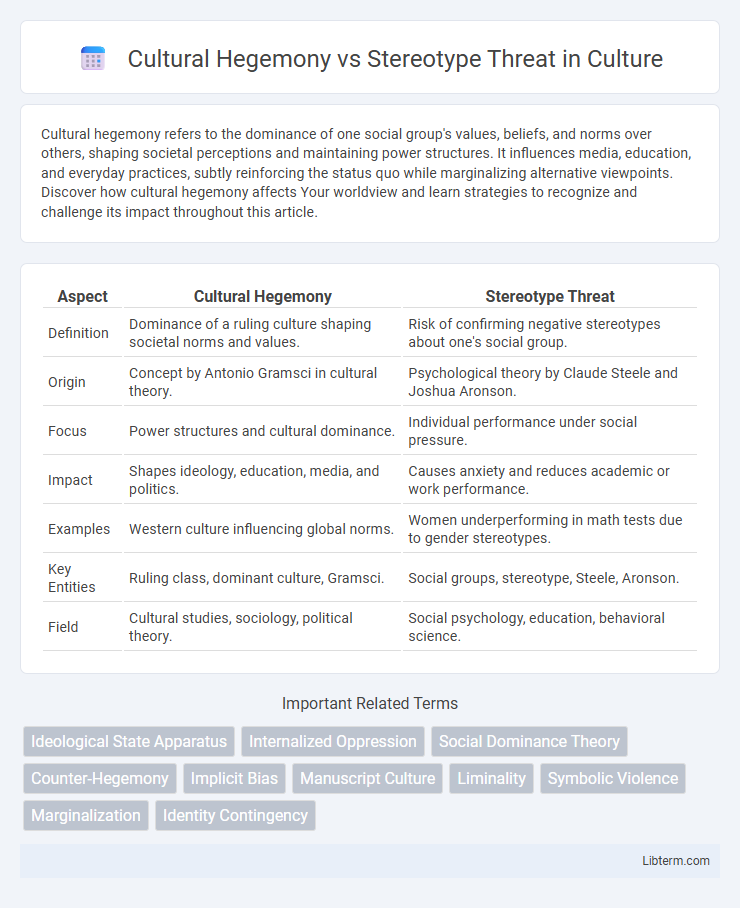Cultural hegemony refers to the dominance of one social group's values, beliefs, and norms over others, shaping societal perceptions and maintaining power structures. It influences media, education, and everyday practices, subtly reinforcing the status quo while marginalizing alternative viewpoints. Discover how cultural hegemony affects Your worldview and learn strategies to recognize and challenge its impact throughout this article.
Table of Comparison
| Aspect | Cultural Hegemony | Stereotype Threat |
|---|---|---|
| Definition | Dominance of a ruling culture shaping societal norms and values. | Risk of confirming negative stereotypes about one's social group. |
| Origin | Concept by Antonio Gramsci in cultural theory. | Psychological theory by Claude Steele and Joshua Aronson. |
| Focus | Power structures and cultural dominance. | Individual performance under social pressure. |
| Impact | Shapes ideology, education, media, and politics. | Causes anxiety and reduces academic or work performance. |
| Examples | Western culture influencing global norms. | Women underperforming in math tests due to gender stereotypes. |
| Key Entities | Ruling class, dominant culture, Gramsci. | Social groups, stereotype, Steele, Aronson. |
| Field | Cultural studies, sociology, political theory. | Social psychology, education, behavioral science. |
Understanding Cultural Hegemony: Foundations and Implications
Cultural hegemony, a concept developed by Antonio Gramsci, describes how dominant groups maintain power through the control of cultural norms and values, influencing societal beliefs and behaviors without overt force. This hegemonic control shapes individuals' consciousness, often marginalizing alternative perspectives and reinforcing inequalities. Understanding these foundations reveals how cultural hegemony perpetuates systemic dominance and impacts social structures, including the psychological phenomenon of stereotype threat that can impair performance and identity in subordinated groups.
Defining Stereotype Threat: Origins and Impact
Stereotype threat originates from social psychology research by Claude Steele and Joshua Aronson, highlighting how awareness of negative stereotypes about one's group can impair performance and increase anxiety. This phenomenon disproportionately affects marginalized communities in academic and professional settings, reinforcing systemic inequalities. Understanding stereotype threat is crucial for addressing the psychological barriers that hinder equal participation and achievement.
Historical Context: Evolution of Social Dominance
Cultural hegemony, a concept developed by Antonio Gramsci, describes the historical evolution of social dominance where ruling classes maintain power through cultural institutions and ideology rather than force. Stereotype threat, emerging from social psychology research in the late 20th century, reveals how marginalized groups experience anxiety when facing negative stereotypes, undermining their performance and reinforcing existing social hierarchies. Both phenomena illustrate enduring mechanisms of social control that maintain hierarchical dominance by shaping beliefs, behaviors, and identity.
Mechanisms of Cultural Hegemony in Modern Society
Cultural hegemony operates through the dominance of a ruling class's worldview, normalizing its values and beliefs as societal norms via media, education, and institutional policies. This mechanism perpetuates power by shaping collective consciousness and marginalizing alternative perspectives, reinforcing social hierarchies. Modern society's acceptance of hegemonic culture limits critical awareness and cultural diversity, indirectly sustaining systemic inequalities.
The Psychological Effects of Stereotype Threat
Stereotype threat triggers anxiety and self-doubt in individuals aware of negative stereotypes about their social group, leading to impaired cognitive performance and reduced motivation. This psychological effect undermines academic achievement and exacerbates achievement gaps, particularly among marginalized communities. Persistent exposure to stereotype threat contributes to long-term self-fulfilling prophecies, reinforcing social inequalities linked to cultural hegemony.
Intersections: How Hegemony Fuels Stereotype Threat
Cultural hegemony reinforces dominant ideologies that marginalize minority groups, creating environments where negative stereotypes are internalized and perpetuated. This power dynamic intensifies stereotype threat by embedding systemic biases into social institutions, educational systems, and media representations. Consequently, individuals facing stereotype threat experience increased anxiety and reduced performance, perpetuating cycles of social inequality and cultural dominance.
Education Systems: A Case Study of Both Phenomena
Cultural hegemony in education systems manifests through the dominance of a particular cultural narrative, shaping curricula and reinforcing social hierarchies that privilege specific groups. Stereotype threat emerges when students from marginalized backgrounds experience anxiety about confirming negative stereotypes, leading to impaired academic performance. This case study highlights how entrenched cultural dominance perpetuates inequities while stereotype threat exacerbates achievement gaps, underscoring the need for inclusive pedagogical reforms.
Media Representation: Shaping Beliefs and Identities
Media representation plays a crucial role in reinforcing cultural hegemony by perpetuating dominant ideologies that marginalize minority groups, shaping public beliefs and maintaining social hierarchies. Stereotype threat emerges when individuals internalize negative media portrayals, leading to anxiety and diminished performance in various domains, reinforcing the cycle of inequality. Analyzing specific media content reveals how narratives either challenge or sustain oppressive stereotypes, influencing identity formation and social behavior across diverse communities.
Strategies for Resistance and Empowerment
Strategies for resisting cultural hegemony and stereotype threat involve promoting critical consciousness through education and encouraging positive identity affirmation among marginalized groups. Empowerment is achieved by creating inclusive spaces that validate diverse experiences and foster collective action to challenge dominant narratives. Community-based programs and media representation are effective tools in dismantling oppressive stereotypes and reinforcing social resilience.
Pathways Toward Equity: Challenging the Status Quo
Cultural hegemony maintains dominant group norms that marginalize minority perspectives, reinforcing systemic inequities through normalized power structures. Stereotype threat undermines individual performance by inducing anxiety from negative cultural assumptions, perpetuating disparities in educational and professional settings. Addressing these issues requires transformative policies and inclusive practices that disrupt dominant narratives and foster equitable environments.
Cultural Hegemony Infographic

 libterm.com
libterm.com